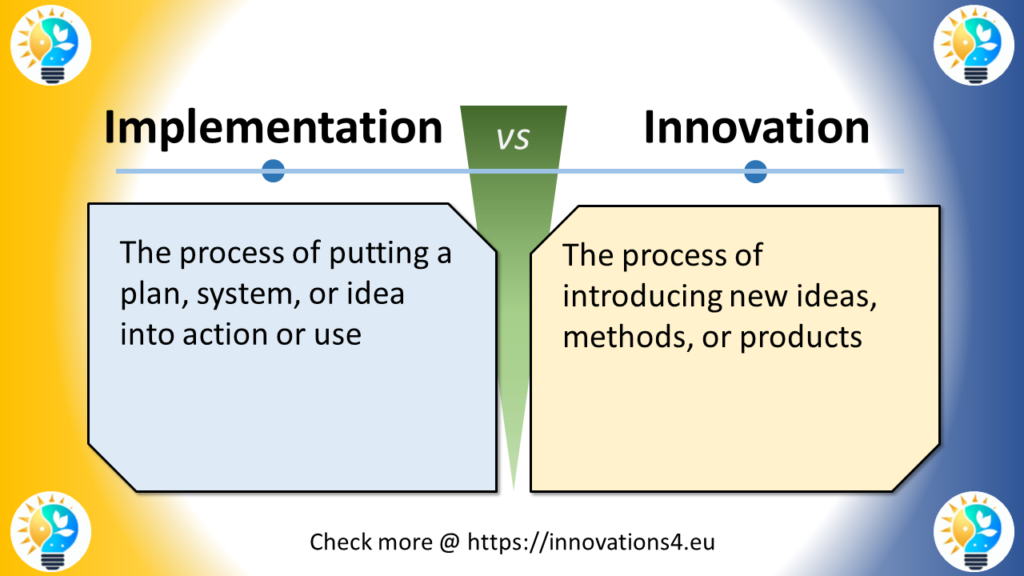
Innovation and implementation are two distinct but interconnected concepts in the realm of business and technology.
While innovation focuses on creating new ideas or improving existing ones, implementation involves putting those ideas into practice.
Introduction
In today’s rapidly evolving business landscape, organizations must balance creativity with execution to stay competitive. Understanding the difference between innovation and implementation is crucial for effectively managing change and driving progress.
Definition
Innovation
Innovation is the process of creating new ideas, products, or methods, or significantly improving existing ones.
Characteristics of innovation:
- Focuses on creativity and originality
- Involves problem-solving and critical thinking
- Often requires risk-taking and experimentation
- Can be incremental or disruptive
- Aims to add value or address unmet needs
Implementation
Implementation is the act of putting ideas, plans, or strategies into action within an organization or system.
Characteristics of implementation:
- Focuses on execution and practical application
- Involves planning, resource allocation, and project management
- Requires attention to detail and systematic approach
- Often faces resistance or challenges during execution
- Aims to realize the benefits of innovation
More Synonyms on innovation, innovate and innovative
Innovation Terms

Innovation is considered as a driving force in progress.
It includes the introduction of novel ideas, methods, or products that bring positive change and advancement.
For more information about innovations, check our glossary
Relationship and Relevance
Innovation and implementation are complementary processes that work together to drive progress and change. Innovation provides the spark of creativity and new ideas, while implementation turns those ideas into tangible results. Without effective implementation, even the most brilliant innovations may fail to deliver value. Conversely, implementation without innovation can lead to stagnation and a lack of competitive advantage.
The distinction between innovation and implementation lies in the nature and focus of each process within an organization.
Innovation refers to the creation of new ideas, methods, or products. It involves introducing something novel or making significant improvements to existing concepts. Innovation can be incremental, radical, or revolutionary, and it requires a creative mindset, openness, and enthusiasm to explore new possibilities[2][3]. It is often associated with the initial stages of development, where ideas are generated and conceptualized[4].
Implementation, on the other hand, is the process of executing and bringing those innovative ideas to fruition. It involves the practical application of these ideas, turning them into tangible products or processes. Implementation requires discipline, reliability, and a structured approach to ensure that the innovation is effectively integrated into the organization's operations[3][4]. It is often seen as the "grind" that follows the excitement of innovation, requiring persistence and attention to detail[1][5].
In summary, while innovation is about generating and conceptualizing new ideas, implementation focuses on the practical execution and integration of these ideas into the organizational framework. Both are crucial for achieving sustainable success, as innovation without implementation remains an unfulfilled potential, and implementation without innovation lacks fresh ideas to drive progress[1][4][5].
Context for Usage
Innovation Context
- Research and development departments
- Brainstorming sessions and ideation workshops
- Startup incubators and accelerators
- Design thinking processes
- Patent applications and intellectual property development
Implementation Context
- Project management and execution
- Change management initiatives
- Product launches and market rollouts
- Process improvement and optimization efforts
- Technology adoption and digital transformation
Examples
Innovation Example
Tesla's development of long-range electric vehicles with advanced autonomous driving capabilities represents a significant innovation in the automotive industry.
Implementation Example
The rollout of contactless payment systems by banks and retailers during the COVID-19 pandemic demonstrates effective implementation of an existing technology to address new challenges.
FAQ
Q1: Can innovation occur without implementation?
A1: Yes, innovation can occur without implementation, but its value remains unrealized until put into practice.
Q2: Is implementation always successful?
A2: No, implementation can face challenges and may not always succeed, even with well-designed innovations.
Q3: Which is more important, innovation or implementation?
A3: Both are crucial for organizational success; innovation drives progress, while implementation ensures practical results.
Q4: Can implementation lead to innovation?
A4: Yes, the process of implementation can often reveal new opportunities for innovation and improvement.

